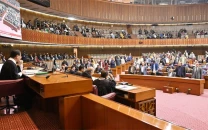Old habits die hard: Saudi Arabia struggles to end oil addiction
Overall, Aramco diversifies, while other projects progress slowly

Overall, Aramco diversifies, while other projects progress slowly. PHOTO: REUTERS
Negotiators had just finished hammering out the details. His last-minute flight, underlined the importance of the deal both to Saudi Arabia and its huge state oil firm.
The planned investment in the $44 billion refinery and petrochemical project, located on India's west coast, is a prime example of how Aramco is trying to squeeze value out of each barrel of oil it produces by snapping up refining capacity, mainly in fast-growing Asia.
In addition, it also underlines the challenge Saudi Arabia faces in reducing its heavy economic reliance on oil. The results of its programme to diversify, have been mixed, some projects are moving slowly and others are too ambitious, economic and energy analysts say.
Prince Mohammed's stated goal of being able to "live without oil" by as early as 2020 looks set to be missed. "Saudi Arabia's oil addiction is as strong as ever... economically, of course, the Saudi economy runs on oil. Oil still dominates GDP, exports and government revenues," said Jim Krane an energy fellow at Rice University's Baker Institute.
"That said, Saudi Arabia is changing its relationship with oil. The dependence remains. But the kingdom is squeezing more value out of its oil," he said. The slow progress means the Saudi economy is likely to remain hostage to oil prices for longer than planned. Any delay in implementing change also risks denting Prince Mohammed's image as a reformer."
Announcing his plan three years ago, the crown prince said Saudi Arabia must end its "oil addiction" to ensure the world's biggest oil exporter and second largest producer cannot be "at the mercy of commodity price volatility or external markets."
He spoke after a fall in crude oil prices boosted the Saudi fiscal deficit to about 15% of gross domestic product in 2015, slowing government spending and economic growth. This year the deficit could hit 7% of GDP, according to the International Monetary Fund (IMF), as oil-related growth slows following production cuts led by the Organization of the Petroleum Exporting Countries (OPEC).
Securing the future
Aramco is central to the crown prince's reform plan in several ways, not least because its planned partial privatisation will generate income for the reforms.
The company has also been involved in most of the kingdom's high-profile deals in the last two years as it increased investment in refining and petrochemicals. During that time, Aramco has announced at least $50 billion worth of investments in Saudi Arabia, Asia and the United States. It aims to triple its chemicals production to 34 million metric tons per year by 2030 and raise its global refining capacity to 8-10 million barrels per day (bpd) from the current figure of five million bpd.
In March last year, Aramco finalised a deal to buy a $7 billion stake in a refinery and petrochemicals project with Malaysia's Petronas. A month later, Nasser and a consortium of Indian companies signed the initial deal that would give Aramco a stake in the planned 1.2 million bpd refinery in India's western Maharashtra state.
In February this year, Aramco signed a $10 billion deal for a refining and petrochemical complex in China. Last month it signed 12 deals with South Korea worth billions of dollars, ranging from ship building to an expansion of a refinery owned by Aramco.
In March, Aramco announced that it was acquiring a 70% stake in petrochemicals firm Saudi Basic Industries (SABIC) for $69.1 billion from the national wealth fund, known as the Public Investment Fund (PIF).
Aramco is gaining new markets for its crude and building a global downstream presence - the refining, processing and purifying end of the production line. Its aim is to become a global leader in chemicals.
"We are not investing left and right, we are investing in the right markets, we are investing in the right refining assets, we are investing where we create value from fuels to chemicals," Abdulaziz al-Judaimi, Aramco's Senior Vice President for Downstream, told Reuters in May.
Nasser, previously known by Aramco employees as Mr Upstream, is leading the downstream expansion. He wants to bring Aramco's refining capacity closer to its oil production potential, which is now at 12 million bpd. Aramco wants gradually to match the downstream presence of its big competitors and, like Saudi Arabia as a whole, to reduce its vulnerability to any downturn in demand for crude oil or oil price volatility.
But overall, plans to wean Saudi Arabia of oil have advanced slowly. Few details have emerged of a $200-billion solar power-generation project announced by the PIF and Japan's SoftBank in March 2018. It is unclear how or when the project will be executed, and Saudi's Arabia's energy ministry is moving ahead with its own solar projects.


















COMMENTS
Comments are moderated and generally will be posted if they are on-topic and not abusive.
For more information, please see our Comments FAQ